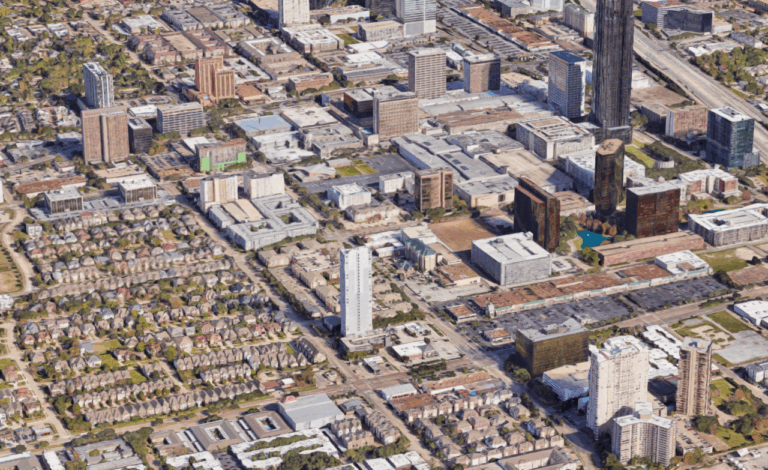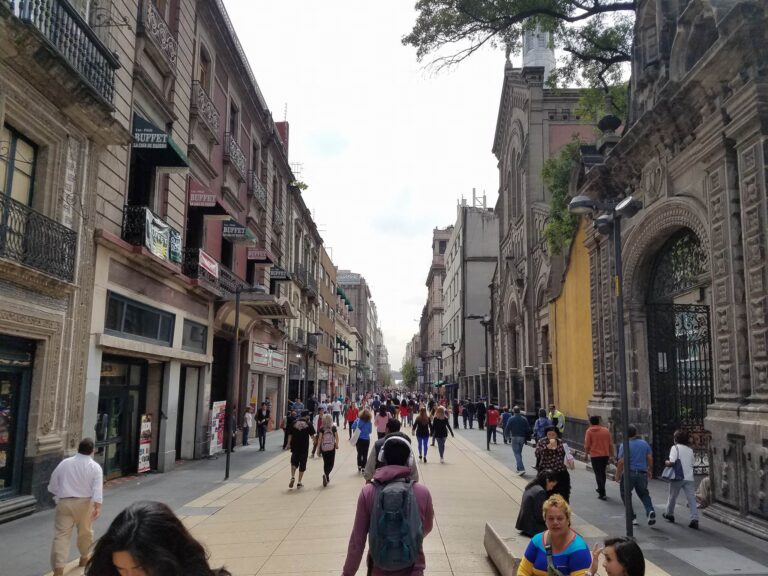Physical Address
304 North Cardinal St.
Dorchester Center, MA 02124
Physical Address
304 North Cardinal St.
Dorchester Center, MA 02124

If you regularly read about cities, you might notice that Texas cities rarely seem to come up. We make cases for why Detroit is definitely coming back—just you wait! We come up with elaborate theories of how cities can become the next Silicon Valley. We spend hours coming up with a solution to New York City’s costumed panhandler problem. Yet the four urban behemoths of the Lone Star State—Houston, San Antonio, Dallas, and Austin—remain conspicuously absent from the conversation. Boy, has that changed. Earlier this year I wrote a sprawling defense of Houston. Scott Beyer spent the summer writing a series of articles for Forbes profiling the cool things happening in cities across the state. John Ricco recently launched the “Densifying Houston” Twitter feed and discussed the phenomenon on Greater Greater Washington. Just this past weekend, City Journal released an entire special issue dedicated to Texas. Through all this, many have been surprised to learn that a city like Houston could serve as a model for land-use policy and economic growth for struggling coastal cities. Yet two criticisms regularly seem to come up, at least related to Houston: “Houston is an unplanned hell-hole! It’s proof that land-use liberalization would be a disaster.” “Houston isn’t unplanned! It’s as heavily planned as any other city, just look at the covenants.” Since there seems to be a lot of confusion about land-use regulation and planning in Houston, here’s a quick explainer on what Houston does regulate, doesn’t regulate, and how private covenants shape the city. 1. What Houston Doesn’t Do Houston doesn’t mandate single-use zoning. Unlike every other major U.S. city, Houston doesn’t mandate the separation of residential, commercial, and industrial developments. This means that restaurants, homes, warehouses, and offices are free to mix as the market allows. As many have pointed out, however, market-driven separation of incompatible uses—think […]

When I was scheduling out the first few episodes of the Market Urbanism Podcast, it seemed natural to start with one of Market Urbanism’s favorite topics: the relationship between land-use regulation and rising housing costs in American cities. This week I sit down with Emily Hamilton, a regular Market Urbanism contributor and policy manager at the Mercatus Center at George Mason University, to discuss a recent paper she coauthored with Sanford Ikeda, “How Land-Use Regulation Undermines Affordable Housing.” The question I am left pondering: how can we convince homeowners—who have a large vested interest in the current system—to support land-use liberalization? Feel free to share your thoughts on this and other topics in today’s episode in the comment section below or with Emily and I on Twitter. Click here to listen to last week’s episode. Our theme music is “Origami” by Graham Bole, hosted on the Free Music Archive. A few general updates/requests: I am excited to announce that we are now on all major podcasting platforms: iTunes, PlayerFM, Pocket Casts, Stitcher, and Soundcloud. If you like what you’re hearing, go ahead and click “subscribe” and leave a review on your favorite platform. If your preferred podcast platform is missing, let me know in the comments below. How would you improve the podcast? Since my goal here is to provide nice content for the Market Urbanism community, I would like to hear your feedback on the show. Thanks for your patience as I familiarize myself with the technical side of podcasting and grow as an interview. Who is a guest you would like to hear on the show? Let me know in the comment section below. If you prefer to keep your suggestion private, feel free to direct message me on Twitter. As always, thanks for listening! We have a few exciting interviews lined […]

This piece was coauthored by Nolan Gray and Katarina Hall. It’s like Los Angeles, but worse. To many, that’s the mental image of Mexico City: a city of unending traffic, unbearable smog, and unrestrained horizontal expansion. Yet when one walks the streets of Mexico City, a distinct reality comes into view: a city of wide sidewalks and integrated bike lanes, lush parks and cool street tree canopies, and dense, mixed-use urban neighborhoods. As a matter of fact, nearly every neighborhood within Mexico City’s giant ring road—the Circuito Interior—has a walkscore above 95. Many major U.S. cities lack even one neighborhood with such a high score. Even on the outer fringe of Mexico’s sprawling Distrito Federal, neighborhoods often have walkscores upwards of 70, qualifying as “very walkable.” What makes Mexico City so walkable? The first thing an American might notice about Mexico City is just how busy the city’s sidewalks are. It’s a city of 21,339,781, and it shows. But this busyness isn’t a mere side-effect of size; it’s a natural result of the city’s generous sidewalks and high-quality pedestrian infrastructure. Many downtown roads host spacious sidewalks, accommodating an unending sidewalk ballet of commuters, tourists, and street vendors. Wide medians along major boulevards offer both refuge for crossing pedestrians and a public space in which people are encouraged to meet and relax. Many of the city’s busiest downtown areas have been closed to automobile traffic. Mexico City’s main road—Paseo de la Reforma—is reserved on Sundays for pedestrians and cyclists. “Jaywalking” is normal and in many cases is assisted by traffic police—a stark contrast to the near persecution pedestrians often face in U.S. cities. The ample space for pedestrians attracts not only foot traffic but also the people watchers who come to enjoy the vitality, in turn keeping many downtown […]
This month marks the 100th anniversary of two pieces of legislation that revolutionized the way we live. On July 11, 1916, President Woodrow Wilson signed the first Federal Aid Road Bill. And on July 25, 1916–exactly 100 years ago today–New York City passed the country’s first comprehensive zoning ordinance. Prior to 1916, transportation infrastructure was primarily a local and/or private responsibility. For example, cities leased their rights-of-way to trolley companies, which operated transit lines. Railroad companies provided travel service between cities. The 1916 Federal Road Bill was the first step in nationalizing transportation infrastructure funding, with the state highway departments formed to manage federal appropriations for roads. These two pieces of legislation produced radical change, as government favoritism of automotive infrastructure crowded out other transportation modes and undermined innovation. In the century prior to 1916, entrepreneurs invented steam ferries, trains, bicycles, trolleys, and automobiles. Such advances ceased after 1916. Yes, today’s cars are more comfortable and powerful, but they have the same steering wheel, four tires, and internal combustion engine as the Model-T Henry Ford was building 100 years ago. As for roads, the main difference is they are bigger. Unable to compete with government favored automobiles, Charleston’s last private ferry operator closed shop in 1930. Its trolley lines, which carried 20 million passengers/year (compared with CARTA’s 5 million/year) stopped running in 1937. Zoning is segregation – not only of land uses deemed incompatible, but of people deemed “undesirable.” Progressives behind New York City’s 1916 zoning ordinance regarded immigrants moving into northern cities from Europe and the South as “undesirable.” In 1921, then U.S. Secretary of Commerce Herbert Hoover tapped Edward Bassett, the leading advocate of New York City’s 1916 zoning, to create a model zoning ordinance. Engineer Morris Knowles also served on this committee. In its 1926 landmark decision in Euclid v. […]

Monday, Y-Combinator, an early-stage technology startup incubator, announced it will “study building new, better cities.” Some existing cities will get bigger and there’s important work being done by smart people to improve them. We also think it’s possible to do amazing things given a blank slate. Our goal is to design the best possible city given the constraints of existing laws. They are embarking on an undertaking of noble intentions, and I will explain why the technology sector needs to be at the forefront of thinking about cities. However, in the pursuit of designing “new” cities from a “blank slate” they have begun their quest with one fatally flawed premise, that wise technocrats can master-build entirely new cities catering to the infinitely diverse set of needs and desires of yet-to-be-identified citizens. Any visions of city-building must first humbly acknowledge that cities are an “emergent” phenomena. According to wikipedia, “emergence is a process whereby larger entities, patterns, and regularities arise through interactions among smaller or simpler entities that themselves do not exhibit such properties.” What makes cities vibrant are the “spontaneous order” which emerges among city dwellers as they pursue their individual desires. Cities are like the internet – networks, patterns, and interactions emerge not through design but from spontaneous order. Like no entity could conceivably understand or control the internet, no entity has the knowledge to anticipate the desires of millions of individual agents, and design a city accordingly. This is called the “knowledge problem.” According to economist Friedrich Hayek: If we can agree that the economic problem of society is mainly one of rapid adaptation to changes in the particular circumstances of time and place, it would seem to follow that the ultimate decisions must be left to the people who are familiar with these circumstances, who know directly of the […]

A metropolitan economy, if it is working well, is constantly transforming many poor people into middle-class people, many illiterates into skilled people, many greenhorns into competent citizens. … Cities don’t lure the middle class. They create it. – Jane Jacobs, The Death and Life of Great American Cities If you follow urban issues in the press, you might be forgiven for thinking that there are only three cities in America: San Francisco, New York, and Portland. All three are victims of their own success, as rising demand for housing has increased rents to unsustainable levels. Despite their best efforts, from rent control to inclusionary zoning mandates, middle- and lower-class households are increasingly forced to leave these cities as each progressively transforms into a playground of the rich. Yet there is a fourth city, a city which must not be named except to be derided as a sprawling, suburban hellscape. This fourth city has managed to balance a booming economy, explosive population growth, and affordable housing. This city has—as cities have for thousands of years—steadily grown denser, more walkable, and more attractive to low-income migrants seeking opportunity. This city is Houston, and it’s well past time for her to come out of the shadows. Explosive Economic Growth, Booming Population, Functioning Housing Market Before jumping into the nitty-gritty of how Houston has handled explosive growth in the demand for housing, it is worth first getting a handle on the magnitude of the challenge facing the city. When many people think of the Houston economy, they understandably think of large energy companies. Indeed, energy companies dominated Houston’s economy for much of the last century and continue to play a major role today. But in the years following the 1980s oil glut, Houston’s economy has been diversified in large part by startups and emerging small […]
Since new urbanists (in my experience) tend to be very skittish of high-rise development, one might think that their ideological ancestor Jane Jacobs was one of these people who thought no building should be over five floors. But in her 1958 essay “Downtown Is For People,” she hinted at a very different view, describing New York City’s Lever House and Seagram Building as among the city’s “extraordinary crown jewels.” Similarly, she described San Francisco’s Union Square (which bordered buildings of wildly varying heights) as “the city at its best.” Jacobs was not against height–but she was against monotony. She wrote, for example, that Park Avenue should “have the most commercially astute and urbanite collection possible of one- and two-story shops, terraced restaurants, bars, fountains and nooks.” So I’m not sure she would have favored the common modern idea that high-rise and low-rise buildings should be segregated from each other, or that buildings of different density are “out of scale.”
[Research help for this article was provided by UCLA student Hunter Iwig] The rent in LA has gone up 30% in the last three years. What the hell? Three big things happened, two of them awesome, and one dumb. We decided living in cities was cool again (awesome), city centers are creating tons of new jobs (awesome), and we didn’t build very many new places to live in our cities (not awesome). Living in cities is cool again (awesome) In the 1950s and 1960s our cities stopped growing and people started moving to the suburbs. We kept it up for a long, long time. But something has changed in the last 10-15 years. More and more people prefer to live in walkable, urban areas. Today, 52% of Americans say they would like to live in a place where they do not need to use a car very often. For millennials, it’s even higher – 63% say they want the walkable convenience of cities. City dwellers do less environmental damage and cause less traffic, so that sounds like pretty damn good news. Cities are creating tons of jobs (awesome) New jobs used to be created in suburbs. But since the Great Recession until 2011, that’s changed – cities are where the new jobs are. And, surprise surprise, people want to move to places where they can get jobs. We’ve made it incredibly hard to build more houses in LA and other cities (not awesome) First, a quick primer. You can’t build anything you want wherever you want. Zoning and planning rules dictate what can be built on any given plot of land. In 1960, L.A. had a population of 2.5 million, but its zoning rules allowed for housing for 10 million if every lot was built to it’s maximum density. Today our […]
[editor’s note: This article was originally posted at Medium.com, and republished with permission of the author, Zachary Caceres. Below are links to some of the Free Market Urbanism writings and speaking of Patrik Schumacher, Partner at Zaha Hadid Architects. Schumacher’s writing is often too dense for me to parse, but Caceres does a great job of breaking it down.] Free Market Urbanism – Urbanism Beyond Planning I Am Trying to Imagine a Radical Free Market Urbanism Illinois Institute of Technology Lecture On “Free Market Urban Order” The Bottom-Up Urbanism of Patrik Schumacher What is the “Radical Free Market Urbanism” of Patrik Schumacher? Here’s his deal as I understand it, gleaned from reading Schumacher’s nearly impenetrable essays. Schumacher believes that architecture and urban design is at a crossroads. The styles that animated the mid-20th century are dead, because they depended too much on central planning (the sort of zoning and design that Jane Jacobs hated). Modernism is dead and was the last truly coherent architectural design philosophy or style. But postmodernism isn’t really anything. He calls it the ‘garbage spill’ approach to urban design—where anything goes in such a way that you get an incoherent sprawling mess. Many modern American cities are like a Frankenstein of awful central planning and unstructured garbage spill. So he proposes Parametric Design, a new—and to Schumacher—coherent 21st century design style. Parametricism is a conscious adaptation of insights from complex systems theory to design. Fundamentally, parametric design is like a fusion of agent-based modeling with complex computation enabled by computers. These models are about tying elements together rather than imposing a vision from above. With so many linked dependent variables, the design takes on qualitatively different forms as you manipulate the independent variables. It’s like ‘emergence’ in biological systems. Parametric design makes plans easily editable and manipulable even after construction […]

Inclusionary Zoning is an Oxymoron The term “Inclusionary Zoning” gives a nod to the fact that zoning is inherently exclusionary, but pretends to be somehow different. Given that, by definition, zoning is exclusionary, Inclusionary Zoning completely within the exclusionary paradigm is synonymous with Inclusionary Exclusion. What is Inclusionary Zoning? “Inclusionary Zoning” is a policy requiring a certain percentage of units in new developments to be affordable to certain income groups. Sometimes, this includes a slight loosening of restrictions on the overall scale of the development, but rarely enough loosening to overcome the burden of subsidizing units. Many cities, particularly the most expensive ones, have adopted Inclusionary Zoning as a strategy intended to improve housing affordability. Often, demand for below-market units are so high, one must literally win a lottery to obtain a developer-subsidized unit. Economics of Exclusion We must first acknowledge the purpose of zoning is to EXCLUDE certain people and/or businesses from an area. Zoning does this by limiting how buildings are used within a district, as well as limiting the scale of buildings . These restriction cap the supply of built real estate space in an area. As we know from microeconomics, when rising demand runs into this artificially created upward limit on supply, prices rise to make up the difference. As every district in a region competes to be more exclusive than its neighbors through the abuse of zoning, regional prices rise in the aggregate. Since the invention of the automobile, and subsequent government overspending on highways, sprawl has served as the relief valve. We’ve built out instead of up for the last several decades and this sprawl has relieved some of the pressure major metropolitan areas would have otherwise felt. In fact, it’s worked so well–and led to the abuse of zoning rules for such a long time–that exclusionary zoning has become the accepted paradigm. Zoning is the default flavor of […]